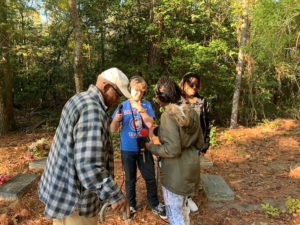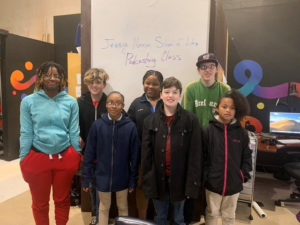This week the Georgia Historical Society highlights the newest Georgia Historical Marker, The Riot of May 11-12, 1970, in Augusta, Georgia. In consideration of social distancing precautions, the marker’s sponsors, The Lucy Craft Laney Museum of Black History and The Augusta Riot 50th Observance Committee are participating in a virtual rollout of the historical marker in lieu of an in-person marker dedication.
This week we will share blog posts examining the people and events surrounding the riots in May 1970. In today’s guest blog post, written by journalist and educator Sea Stachura, learn about the public history project conducted by Sea and Jessye Norman School of Arts students about the Augusta Riot.

Students visit and record audio at the grave of Charles Oatman with Lenton Oatman, the teen’s uncle.
In October of 2019, I took a small group of my students at Jessye Norman School of the Arts (JNSA), to visit the gravesite of Charles Oatman. Oatman was the 16-year-old, intellectually disabled teen whose death sparked outrage and led to Augusta’s riot. The event was the Deep South’s only major Civil Rights-era riot, and until this class, none of the students had heard of the event. Guiding us there was Charles’s uncle, Lenton Oatman. I hoped the visit would help students begin to connect the riot, an unfamiliar, historic event with their present tense lives.
The school’s namesake, Ms. Jessye Norman, and her brother Silas Norman were deeply involved in the movement for racial equity. The school continues that legacy as part of its mission. I had been doing research on the uprising for many years, and the 1970 Augusta Riot Observation Committee was preparing to educate the public on this significant but buried event. It was the perfect time for the school to approach Georgia Public Broadcasting with plans for a collaborative podcast project. We hoped if the students learned the history firsthand and participated in unpacking its relevance, they would incorporate the knowledge into their understanding of current events and racism.
JNSA students worked with me, an educator and journalist, to create a documentary podcast that explores the circumstances leading up to the uprising, the uprising itself, and the changes in Augusta over the past 50 years. The six episodes and additional bonuses tell personal stories of courage, degradation, and loss that changed the face of central Augusta and the relationships between whites and Augustans of color. I began interviewing people connected to the uprising in 2011, while teaching at Augusta University. Since then, I’ve conducted over 50 interviews and gathered more than 900 pages of declassified FBI documents. I’m also a member of the 1970 Augusta Riot Observation Committee, which supported me in my research.

Members of the JNSA Podcasting class (left to right) Essence Willingham, Atticus Dillard-Wright, Khalia Crawford, Jalia Burns, Aidan Allen, Thomas Collins, Gabbie Stallings (not pictured: Emerson Hudson, Tiara Dugger, Kaleyah Turmon, Aijalon Henderson)
Students learned from this information and gathered their own. They did several site visits and conducted a few interviews, too. But, most importantly to the podcast, they provided honest feedback about their learning. Is it still possible for another Black teen to die as Charles Oatman did? Why wouldn’t guards stop this violence from happening? Is what happened a riot or an uprising, and what is the difference? Is the racism experienced by 1970 Black residents less or more severe than it is today? Does this mean police are bad? Not all of these questions made it into the podcast, but many did. They were what prompted students to face their assumptions and their ignorance, and do it in a mixed-race setting.
Thus far, “Shots in the Back” has been downloaded close to 300,000 times. Listeners come from across the nation (including in California, Hawaii, Minnesota, Illinois, Alabama, and New York) and around the globe. But most come from the state of Georgia. They are seniors who remember the event but never knew why it happened, teachers who haven’t had a resource about it, and younger generations who were never told the Civil Rights Movement happened in their hometown.
Explore the following links to learn more about the Riot of May 11-12, 1970:
